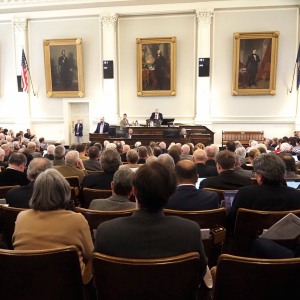Column: Gov. Scott should be patient with school reform

Contributor Wayne Gersen in West Lebanon, N.H., on April 12, 2019. (Valley News - Geoff Hansen) Copyright Valley News. May not be reprinted or used online without permission. Send requests to permission@vnews.com.
| Published: 04-12-2025 8:31 AM |
Vermont Gov. Phil Scott recently expressed frustration with the House for its reluctance to move forward with his plan to consolidate Vermont’s school districts. The governor and some legislators see consolidation as the best way to control and contain spending on public education and sees no reason to delay his recommendation to transition to a new funding formula and “a new governance structure that unlocks transformation.”
Consolidation can save some money quickly. Done deliberately, though, thoughtful consolidation could also improve the lives of children and families, strengthen the communities where schools are located and secure long-term savings.
Having worked within several governance structures during my career, I witnessed how the Boards of Cooperative Education Services (BOCES) in New York saved money through economies of scale, how large county school systems in Maryland County realized savings through interagency cooperation, and how Maine’s financial incentives to create regional high schools in the 1960s resulted in upgraded school buildings, improved opportunities for students and provided benefits for communities.
In New York State, where I led Wappingers School District in the late 1990s and early 2000s, Duchess County’s BOCES provided a wide array of services for the 13 districts in the county. The BOCES managed vocational education programs, provided technical support in technology and special education, facilitated group purchasing for computers, instruction equipment and supplies, heating oil and fuel for our bus fleet. It also hired specialized staff that could be shared among districts, and formed a pool with three other BOCES to realize savings in all forms of insurance.
In the decade I led the Washington County, Md., school district, which housed 17,000 students in 42 schools, we formed partnerships with social service agencies and nonprofit organizations that served children, partnerships that saved money for our county and assisted the working parents in the district.
In the early 1990s the state mandated that schools provide nurses for each of our schools. At that time, we had only four on our staff. To fulfill the mandate, we forged an alliance with the county health department, outsourcing the management and oversight of school nurses to them. This enabled us to realize substantial savings, since we did not need to hire administrators to manage the hiring, personnel management costs and evaluation of nurses.
We also formed a partnership with the county social services agency, offering office space in four schools whose neighborhoods had heavy caseloads of children needing services, making it possible to provide onsite support for children facing serious challenges. Finally, we invited nonprofits to provide child care before and after school in each of our 24 elementary schools, offering them space in our schools for minimal cost so that we could cover any costs incurred as a result.
The integration of health and social services was possible because our school district served the same catchment area as those agencies, something Vermont officials should keep in mind as they determine the boundaries for the proposed consolidated districts.
Article continues after...
Yesterday's Most Read Articles
 Citing insufficient evidence, county attorney declines to prosecute former Lebanon Public Works employees who were accused of theft
Citing insufficient evidence, county attorney declines to prosecute former Lebanon Public Works employees who were accused of theft
 Dartmouth alumnus gets 20-to-40-year sentence in rape case
Dartmouth alumnus gets 20-to-40-year sentence in rape case
 President of Vermont Law and Graduate School to step down this summer
President of Vermont Law and Graduate School to step down this summer
 Walkout at Dartmouth calls attention to Trump’s attacks on universities, conditions in Gaza
Walkout at Dartmouth calls attention to Trump’s attacks on universities, conditions in Gaza
Maine’s financial incentives to create regional districts in the 1960s improved high school facilities across the state which, in turn, improved educational opportunities for all students. To encourage far flung and diverse communities to merge into regional school administrative districts (SADs), the state offered 90% reimbursement for the bond payments districts incurred to build new high schools and 90% reimbursement for the additional transportation costs. When I was appointed principal of Telstar Regional High School nine years after it opened, there was still grumbling among townspeople in the five communities that merged to build the new high school and oversee the six schools in the district. But the budgets passed every year and the parents in the communities who “lost” their local high schools appreciated the opportunities their children got at Telstar, opportunities that would have been unattainable had the schools remained as they were.
Ultimately, consolidation will help lower costs only if it facilitates the reduction of teachers. The savings realized through the consolidation of administrative services and buying in bulk will help marginally. Outsourcing health and social services could save a bit more. But to realize substantial savings, districts need to reduce teaching staff, which would require either the expansion of multi-age classrooms in elementary and middle schools or the construction of new regional schools serving elementary and middle school students that enroll more students at each grade level.
Maine’s experience with consolidation in the 1960s might offer a way for Vermont to save money in the long run and improve the well-being of children, families and communities. A report issued in January 2024 estimated Vermont needed to spend $6.3 billion to upgrade its schools, an amount some public school advocates thought was too low. This appears to be a daunting cost, but a report commissioned by the Vermont Legislature issued in October indicated that if Vermont schools were staffed based on typical pupil-teacher ratios Vermont could save $400 million per year. If the approval of new school construction was linked to the ratios used in this report, it would be possible to offset the cost for the bonds for new construction needed to upgrade and/or expand facilities.
I realize the governor wants to proceed quickly, but taking time to flesh out a coherent and comprehensive consolidation plan, one that prepares students for in the future, integrates the services schools are expected to offer and takes facilities upgrades into consideration, would be far more beneficial than adopting a plan that focuses only on saving money in the short term.
Vermont’s policymakers and politicians need time to sort out the details of the governor’s plan, spend a few months consulting with school leaders and school board members to identify the ramifications of the plan and use these deliberations to plan for the future instead of the focusing on budgets in 2026-27.
Wayne Gersen is a retired public school administrator. He lives in Etna.






 Editorial: New Hampshire budget shortfall is a crisis of Republican design
Editorial: New Hampshire budget shortfall is a crisis of Republican design Editorial: Time is running out for American democracy
Editorial: Time is running out for American democracy Editorial: Jeanne Shaheen blazed a trail in politics
Editorial: Jeanne Shaheen blazed a trail in politics Column: Federal funding for medical research puts America first
Column: Federal funding for medical research puts America first
